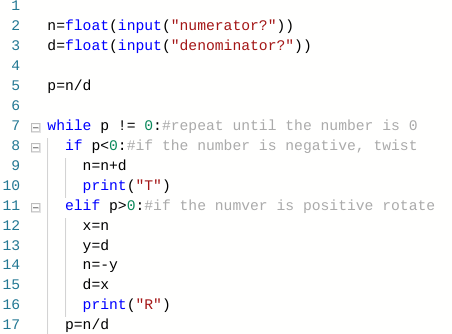More twisting and turning
Problem
More Twisting and Turning printable sheet
This problem follows on from Twisting and Turning in which twisting has the effect of adding $1$ and turning transforms any number into the negative of its reciprocal.
It would be nice to have a strategy for disentangling any tangled ropes...
I wonder if it is always possible to disentangle them...
Choose a fraction to start from.
From your chosen fraction, can you find a sequence of twists and turns that get you back to zero? Remember, twisting: $$x \mapsto x+1$$ and turning: $$x \mapsto -\frac1x$$
Perhaps you might like to start with a negative fraction containing a $2$ as the denominator, such as: $-\frac{5}{2}$ or $-\frac{17}{2}$ or $-\frac{23}{2}$
Can you find a way to get back to zero?
Try to describe an efficient strategy for disentangling any fraction of the form $$-\frac{n}{2}$$
How does this help you get back to zero from a positive fraction with 2 as the numerator, such as $\frac{2}{7}$ or $\frac{2}{15}$ or $\frac{2}{32}$?
Next, you could consider ropes that have been tangled up and have left you with a negative fraction containing a $3$ as the denominator
e.g: $-\frac{5}{3}$ or $-\frac{17}{3}$ or $-\frac{23}{3}$
Try to describe an efficient strategy for disentangling any fraction of the form $$-\frac{n}{3}$$ and use this to suggest a strategy for disentangling any fraction of the form $$\frac{3}{n}$$
Next, you could consider ropes that have been tangled up and have left you with negative fractions containing $4, 5, 6 \ldots$as the denominator, or positive fractions containing $4, 5, 6 \ldots$ as the numerator.
Can you develop a strategy for disentangling any tangled ropes, irrespective of the fraction you have ended up with?
You may want to take a look at All Tangled Up after this.
Getting Started
Take another look at the video in Twisting and Turning.
Can you spot the strategy they used to get back to $0$?
Here is an interactive tool you can use to try out some strategies.
Student Solutions
Rachel thought through the problem like this:
Ved from WBGS in the UK sent in a more general solution:
If the entangled fraction is positive, then rotate,
If it is negative, then twist,
Repeat until the entangled fraction is 0
Ved also wrote a program which takes the numerator and denominator of the tangled ropes as inputs, follows this procedure, and writes a sequence of Ts and Rs to tell you how to untangle the ropes:

Teachers' Resources
Why do this problem?
This problem follows on from Twisting and Turning, in which students are introduced to an intriguing trick which provides a context for practising manipulation of fractions. The trick is a hook to engage students' curiosity, leading to some intriguing mathematics to explore and explain, and ultimately generalise and prove.
Possible approach
After working on Twisting and Turning, students should have seen one sequence of fractions that leads to a tangling and untangling of the ropes, and also disentangled one more sequence. This problem offers an opportunity to explore and find a strategy for disentangling any tangle.
Begin by reminding students of the two operations:
Twisting has the effect of adding 1: $$x \mapsto x+1$$
Turning transforms any number into the negative of its reciprocal: $$x \mapsto -\frac1x$$
"I wonder if it's possible to get back to zero from any fraction...
Let's start by exploring negative fractions with a denominator of 2,
e.g. $-\frac{5}{2}$ or $-\frac{17}{2}$ or $-\frac{23}{2}$.
Using the two operations, can you find a way to get to zero?"
Give students some time to work on this challenge, and then bring the class together to discuss. The following strategy might emerge:
Keep adding $1$ until you get to $\frac12$. Then a Turn gives $-2$ and two more Twists gives $0$.
"So we have a strategy for getting to zero from fractions of the form $-\frac{n}2$. Can anyone explain how this helps us with fractions of the form $\frac2{n}$?"
Start with a twist to get $-\frac{n}2$. Then use our previous strategy.
Next, students could explore fractions of the form $-\frac{n}3$.
This time there are two cases to consider: repeated twists eventually leads to either $\frac13$ or $\frac23$. In the first case, a turn leads to $-3$. In the second case, $\frac23$ is a fraction of the form $\frac2{n}$ so the strategy above can be used.
These explorations should help students to work towards a general strategy for untangling back to zero from any fraction. To finish off the lesson, you could challenge students to untangle a complicated fraction - this could be done practically using ropes or string, or using the interactive tool in the Getting Started section.
Key questions
If you keep adding 1 to a fraction of the form $-\frac{n}2$, what eventually happens?
If you keep adding 1 to a fraction of the form $-\frac{n}3$, what eventually happens?
If you keep adding 1 to a fraction of the form $-\frac{a}{b}$, what eventually happens?
Possible support
Students who are less fluent with fractions might find it useful to use the interactive tool in the Getting Started section to check their answers.
Possible extension
All Tangled Up invites students to explore how to get from zero to particular fractions.
